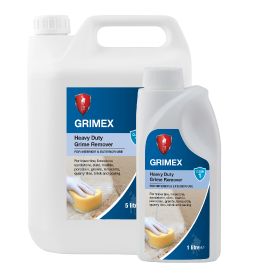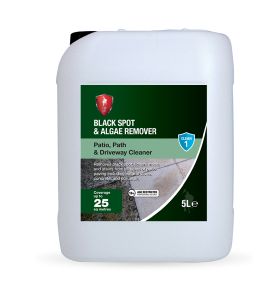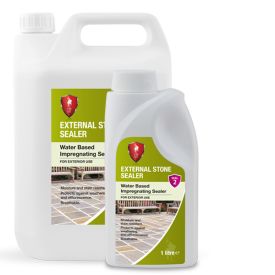
Nothing beats the pristine look of a newly installed patio but after a long, hot spell and lots of use – or a cold, damp winter – it can start to look a little jaded. Paving slabs can become stained by food & drink, sun lotion, animals, plants & leaves and other outside elements. But, with a little effort and the correct tools, slabs can very quickly be restored.
Jet washing may seem like the best method for a fast clean but it will only wash dirt off the surface of the slabs. High pressure water will also damage grout joints. A specialist treatment, on the other hand, will react with the dirt and organic matter, and will help break it down.
A deep & thorough clean
To properly remove stains and ingrained dirt, we recommend a thorough wash with deep cleaner and stain remover, LTP Grimex. Before cleaning, remove furniture, pots and other objects, and sweep the slabs to remove any leaves and residue. Then, test the cleaning solution on an inconspicuous area.
How to apply LTP Grimex:
To remove mild staining, dilute one part of Grimex with 10 parts of warm water. Wash the surface thoroughly, using a brush or garden broom, and rinse with clean water. For more severe staining, dilute one part of Grimex with 3 parts of warm water. Agitate with a scrubbing brush and leave to act for 5-10 minutes, adding more solution to keep the surface wet. Sweep up any residue and rinse thoroughly with clean water.

If your patio is prone to slippery black spot, lichen, moss and algae, it will benefit from a targeted treatment with LTP Blackspot & Algae Remover. This solution is designed to break down microspores and black spot ‘hyphae’ before they colonise and it’s acid-free, so safe to use on acid-sensitive stone. However, it does contain a bleaching action to remove stains, so test first on an inconspicuous area.

How to apply LTP Blackspot & Algae Remover:
Remove furniture and other items from the area to be treated. Apply neat Blackspot onto clean pavers with a plastic watering can or light pressure garden spray. Leave to absorb for 2-4 hours; the product will begin to fizz as it gets to work. Hose off thoroughly with clean water.
Replacing lost grout
Once you’ve cleaned your patio and it’s dry, it’s an ideal time to replace any lost jointing sand or cement mortar. This will stop the ingress of water and will help protect paving during the freeze and thaw cycle in the winter.
Added protection
If your patio hasn’t been sealed, consider applying a protective treatment. We recommend LTP External Stone Sealer for natural stone and LTP Porcelain Tile Protector for matt porcelain pavers. Both treatments are non-film forming and will help prevent the absorption of moisture and organic particles, reducing staining and the spread of algae, mould and black spot.


LTP External Stone Sealer is a water-based, impregnating sealer that’s applied using a foam roller or paint brush. It can be used over residual moisture and will protect pavers from moisture, stains, weathering and efflorescence. It’s also UV resistant and non-yellowing.
LTP Porcelain Tile Protector creates a barrier against organic matter and makes ongoing maintenance easier. On newly laid tiles, it also protects against staining and helps increase working times.
For advice on patio cleaning and protection, please contact LTP on tel. 01823 666213 or email [email protected]



